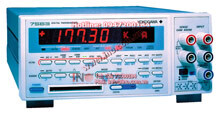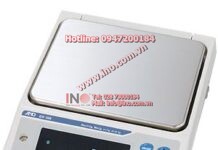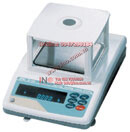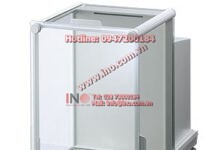Yokogawa-original A/D converter (feedback pulse width modulation method) features superior noise immunity, stability and high-speed sampling. In addition, versatile functions are suitable for system use and cover a wide variety of applications from test to R&D.
The Precision Digital Thermometer offers various computations functions and software calibration functions. The 7563 also features:
- Temperature measurement:
- DC V measurement:
- Resistance measurement:
- Sampling rate:
Accuracy: TC…0.006%, RTD…0.01% Resolution: TC…0.1°C (0.1°F), RTD…0.01°C (0.01°F)
Accuracy: 0.0045% (2000 mV range) Resolution:100 nV (200 mV range)
Accuracy: 0.006% (2000 ohm range) Resolution: 100 µohm (200 ohm range)
Max. 100 times/s (4-1/2 digits)
High accuracy, high resolution and high-speed sampling
 |
For the temperature measurement (RTD), high resolution of 0.01°C (0.01°F) can be obtained. In DC V and resistance measurement, the resolution of 100 nV and 100 μohm can be obtained with high stability. (see below)
In addition, the high-speed sampling rate of up to 10 ms are available for the study of biometeorology/medical development of electronic components where the rapid and precise temperature measurement are required. |
| Drift Data (zero point of DC V) |
3 measuring functions: Temperature, DC V and Resistance
4 types of RTDs (2-wire/3-wire/4-wire) and 12 types of TC's are available for use in a wide range of applications. In addition, DC V and Resistance (2-wire/4-wire) measuring functions are also available in a single instrument.
TC: 12 types (R, S, B, K, E, J, T, L, U, N, W and KPvsAu7Fe) RTD: 4 types (Pt100, JPt100, Pt1000 and J263*B)
High-accuracy reference junction compensation:
 |
| Temperature Characteristics |
Compensation accuracy (±0.2°C) Input terminals are provided on both front and rear panels, and an input site is switch selectable. The rear panel input terminal has an isothermal structure, and it is provided with windbreak cover of one-touch type.
The 7563 uses a YOKOGAWA-original transistor temperature sensor in the reference junction compensation circuit. A compensation accuracy of ±0.2°C (±0.4°C) is realized together with the isothermal structure of the input terminal.
Adjustment function of R0: Reference resistance value of RTD (at 0°C)
Adjustment function of R0 expands the 7563's input ranges. As adjustment range of this function covers 0 to 2,000 ohm with 0.001 ohm resolution, the combination of this function and three ranges for Pt RTD sensor offers the customer to use almost all types of RTD sensors available in the world.
Two types of external reference junction compensation (RJC)
- External RJC with adjustable reference function temperature.
This function means that the user can use any type of reference temperature, such as H2O (t), He (v), O2 (t), Hg (t), Ga (m), Sn (f), Au (f), etc. Adjustment range covers all temperature ranges of 12 thermocouples with 0.1°C (0.1°C) resolution. - Remote RJC utilizing Pt100 sensor (Program Mode).
In this mode, Pt100 sensor measures the temperature of external input terminal, and the 7563 compensates the reference junction temperature of the thermocouple connected to the external input terminal.
IC memory card
IC memory card expands the applicability. It is possible to save up to 8,000 measured data as a buffer memory. It also allows you to save the panel setting conditions and read them automatically at power ON (AUTO LOAD). In addition, measuring parameters can be programmed in up to 20 steps into the IC memory card.
GP-IB or RS-232-C communication interface (standard)
The 7563 incorporates a bidirectional communication function which supports the system use. Not only the measured data output, but also all the functions executed by panel key operation excluding only the power supply ON/OFF operation can be controlled from a host computer by a powerful set of commands.
Versatile mathematical functions
 |
| Temperature Correction by Means of the Scaling Function |
In addition to the noise elimination by moving average function and offset compensation (NULL), a scaling function and comparator function are also available. (Example) When TC is calibrated at a reference temperature (Ts), the correction for measured value (Tx) can easily be obtained by using the scaling function. (Figure 5) Scaling function: (X-A)/B, provided that, A = 0, B = Tx/Ts
Software calibration
Calibration of DC V and W can be executed by simple panel key operation or via communication interfaces. Calibration values for temperature measurement ranges are automatically calculated by only giving reference inputs for DC V and W ranges.
Measuring range
- Auto range mode
When the display data increases more than 20,000/200,000, the range is automatically changed (increased), whereas when the display data goes down to less than 1,800/18,000, the range is automatically changed (decreased). - Manual range mode
If the measuring range exceeds upper-limit setpoint, -oL- (overload) is displayed.
Sampling functions
- Auto mode (AUTO)
Data is sampled at a preset integral time and measuring intervals. - Single mode (SINGLE)
One datum is sampled at the preset integral time every time a trigger signal is generated.
Trigger Functions
The following three ways are available for generating trigger signals.
- Press the TRIG key on the front panel.
- Input a contact signal or TTL logic signal to the I/O signal connector (pin No. 1).
- Send the "E" or GET command through GP-IB or RS-232-C. In STORE mode, triggering performs three types of operations according to measurement modes as follows:
- In AUTO mode, data are written leaving NS-1 data before generating trigger signals and the STORE mode is automatically turned OFF when memory capacity is full. Amounts of data that are written depend on the built-in memory or IC card memory. (Pre-Trigger Function)
- In SINGLE mode, sampled data is stored every time a trigger signal is generated. If NS data that are preset are stored, STORE mode is automatically turned OFF. (Preset Counter Function)
- In N RDGS mode, each NS data is stored every time a trigger signal is generated. N-Reading mode (N RDGS) Data are sampled in the cycles set by the integral time and measuring intervals.
STORE mode is in halt status until the next trigger signal is generated. The STORE mode is automatically turned OFF when memory capacity is full. In RECALL mode, data are recalled whenever a trigger signal is generated according to measurement mode. In AUTO mode, data are automatically recalled at measurement intervals which have been set at the time of recall.
Time Delay Functions
 |
The time interval between a trigger signal generation and the sampling can be set from 0 to 60 minutes. This allows accurate measurements when a signal source has dead-time or the measurement circuit shows a first-order lag response. |
| Time Delay |
Null Functions
Y = X – X0
Where;
X0?: initially set value (NULL value)
Y : computed value
X : measured value
Reset an initially set value (data being displayed) to zero as NULL value. Thereafter a value subtracted by a NULL value is displayed as a measured value. This null function is used to eliminate leadwire resistance or cancel initial values.
Averaging Function (AVG)
The AVG function is used to average the measured data. This comes into effect when noise components or variation of measured data at high-speed sampling must be eliminated from the measured value. The calculation expression is given by:
Y = (XAT?+ XAT-1 + …. + X1) / AT where
AT : 2 to 100 (number of average data)
X : measured value
Y : computed value
Scaling Function
The scaling function serves not only to indicate a multiple with preset multiplying factors but also to determine deviation from a preset reference value.

Comparator Function
The comparator function compares a measured value (or null or averaging values) with the reference value to determine which value is larger or smaller if the measured value is within the limits.

Storing Function
Store the measured data in built-in memory or IC card memory. When an IC memory card is installed, the measured data is stored in the IC memory card.
The STORE function has three operations depending on measurement modes as follows:
- In AUTO mode:
In AUTO mode, press the STORE key to store data in memory. If the memory overflows, the oldest data are automatically erased and replaced by the newest data. If the STORE mode is OFF, data is no longer stored. In AUTO mode, if a trigger signal is generated, data can be written to the memory, leaving NS 1 data before generating a trigger signal. - In SINGLE mode:
In SINGLE mode, data measured in each sampling cycle are stored every time a trigger signal is generated. If NS data that was present are stored, STORE mode is automatically turned OFF. - In N RDGS mode:
NS data are stored every time a trigger signal is generated. The STORE mode is in halt status until the next trigger signal is generated. If the memory overflows, the STORE mode is automatically turned OFF.
Recall Function
Recalls the stored data from the memory. The recall functions are as follows:
- In AUTO mode:
Data are output at the preset measurement intervals. When the final data are output, the recall mode is automatically turned OFF. - n SINGLE mode:
Data are recalled every time a trigger signal is generated. When the final data are output, the recall mode is automatically turned OFF. - In N RDGS mode:
NS data are output at the preset measurement intervals whenever a trigger signal is generated. Then the mode is in the halt state. If the trigger key is pressed again, recalling of data is started. If the final data are output, the recall mode is automatically turned OFF.
IC Memory Card
The 7563 is the first Digital Thermometer with IC memory card (optional).
IC memory card allows you to:
- Save up to 8,000 measured data.
- Save functions, ranges, and mathematical functions ON/OFF, sample speed and so on.
- Store setting programs using the front panel keys and measured data.
- Automatic loading at power ON.
7563 is allowed more applications by the above memory card functions. The data format of memory card is compatible with that of YOKOGAWA LR Series Recorders, so the measured data can be recorded in analog form on strip chart.
Automatic Loading
IC memory cards allow measurement parameters and conditions to be set without using the panel keys. If an IC memory card containing set data is inserted and then the power is turned ON, the memory contents are automatically read and programmings are set.
This is very useful for measurements that are repeated under the same conditions, and this can be a powerful support tool such as in the production line.
Programming Function
If an IC memory card is installed, up to 20 steps can be programmed either by front panel key operations or via communication interfaces.
The required functions, ranges, and mathematical functions can be set ON or OFF, and multichannel measurements can be performed in a combination with scanners.
Auto Zero Function
The AZ key turns ON or OFF AUTO ZERO. AUTO ZERO (AZ) compensates for zero drift which will be generated in the internal circuit every time sampling is executed. In high speed sampling mode, measurement time is decreased by eliminating AUTO ZERO functions.
Calibration Function
The multimeters can be calibrated either by front panel key operations or via communication interfaces. The multi-meters are calibrated without opening the case and without any special calibration skills.
Analog Output (Optional)
This optional feature specifies any data of 3-1/2 or 3 digits on the display and converts it to the analog data with the range of 00 mV or V.
This function is ideal for both long-time temperature measurement and small change of measurement.
Multi-Point Measurement of up to 50 Points
By using a programmable scanner 750101 the multi-point measurement of up to 50 points is possible.





















… [Trackback]
[…] Find More Information here on that Topic: ino.com.vn/khac-do-luong-kiem-tra/yokogawa-digital-thermometer-model7563/ […]
… [Trackback]
[…] Find More to that Topic: ino.com.vn/khac-do-luong-kiem-tra/yokogawa-digital-thermometer-model7563/ […]
… [Trackback]
[…] Find More Information here on that Topic: ino.com.vn/khac-do-luong-kiem-tra/yokogawa-digital-thermometer-model7563/ […]
… [Trackback]
[…] Find More here on that Topic: ino.com.vn/khac-do-luong-kiem-tra/yokogawa-digital-thermometer-model7563/ […]
… [Trackback]
[…] Read More here on that Topic: ino.com.vn/khac-do-luong-kiem-tra/yokogawa-digital-thermometer-model7563/ […]
… [Trackback]
[…] Information on that Topic: ino.com.vn/khac-do-luong-kiem-tra/yokogawa-digital-thermometer-model7563/ […]
… [Trackback]
[…] There you can find 6981 additional Info on that Topic: ino.com.vn/khac-do-luong-kiem-tra/yokogawa-digital-thermometer-model7563/ […]
… [Trackback]
[…] Find More here on that Topic: ino.com.vn/khac-do-luong-kiem-tra/yokogawa-digital-thermometer-model7563/ […]
… [Trackback]
[…] Find More Information here to that Topic: ino.com.vn/khac-do-luong-kiem-tra/yokogawa-digital-thermometer-model7563/ […]
… [Trackback]
[…] Info on that Topic: ino.com.vn/khac-do-luong-kiem-tra/yokogawa-digital-thermometer-model7563/ […]
… [Trackback]
[…] Read More Information here on that Topic: ino.com.vn/khac-do-luong-kiem-tra/yokogawa-digital-thermometer-model7563/ […]